
In a recent astronomical revelation, scientists have detected a galactic-scale “heartbeat” rhythm pulsating within stars billions of light-years away from Earth. This entrancing cosmic rhythm offers a fresh perspective on understanding the universe and its celestial inhabitants.
Understanding the “Heartbeat” Rhythm

The “heartbeat” rhythm is an intriguing phenomenon that has caught the attention of astronomers worldwide. It’s a rhythmic pattern that resonates within stars, similar to the rhythmic beating of a heart. The pattern was detected using a combination of powerful telescopes and cutting-edge data analysis techniques, primarily through radio wave detections.
Interestingly, this phenomenon is not entirely unique in the universe. There are other examples of rhythmic occurrences, like the pulsations of pulsar stars or the oscillations of certain types of variable stars. However, the galactic-scale “heartbeat” rhythm presents a distinctive pattern that sets it apart from these other phenomena.
Implications of the Discovery

The detection of this rhythmic pattern has sparked numerous scientific discussions and theories. One theory suggests that the rhythm might be tied to the stars’ magnetic fields, which could fluctuate in a rhythmic pattern. Another theory connects this rhythm to the life cycle of stars, suggesting a potential link between the rhythm and a star’s age or stage in life.
This discovery doesn’t just broaden our understanding of star behavior, but it also has significant implications for astrophysics and cosmology. The rhythm could serve as a new tool for studying stars and galaxies, helping us better understand the dynamics of the universe. It may also shed light on the enigmatic dark matter, which continues to be a hot topic in the field.
The Stars Involved and Their Characteristics

The stars where this rhythm was detected are specifically chaotic stars – stars that do not follow a predictable brightness pattern. The peculiar nature of these stars has made them difficult to study in the past. However, the discovery of the “heartbeat” rhythm has provided a new perspective on these cosmic entities.
The characteristics of these stars, including their size, type, and location, are being examined to understand what contributes to the presence of the rhythm. The stars studied so far have varied in their characteristics, suggesting that the rhythm might be a universal phenomenon across different types of stars.
The Future of Heartbeat Astronomy

This discovery could significantly shape future astronomical research and exploration. The detection of a rhythmic pattern in stars could pave the way for new methods of studying stars and galaxies. It could help us better understand the evolution of the universe and may have applications in space exploration, providing critical information about distant stars and galaxies.
However, many questions remain unanswered. For instance, why does the rhythm exist? What causes it? Is it present in all stars, or only in specific types? As we continue to explore these questions, the “heartbeat” rhythm promises to remain a fascinating area of study in astronomy.
Breakthroughs and Controversies in the Field

The field of astronomy is rife with exciting breakthroughs that continually reshape our understanding of the universe. For instance, the recent discovery of gray cygnets, a new class of celestial bodies, has stirred up the astronomical community. Similarly, the detection of the “heartbeat” rhythm in stars is another significant milestone that adds to our collective knowledge.
However, like any scientific discovery, it’s not without its controversies. While some astronomers see the rhythm as a groundbreaking discovery, others are more skeptical, awaiting more concrete evidence before jumping to conclusions. As ongoing research and technological advancements continue to push the boundaries of our knowledge, such debates are an integral part of the scientific process, driving us towards a more profound understanding of the universe.